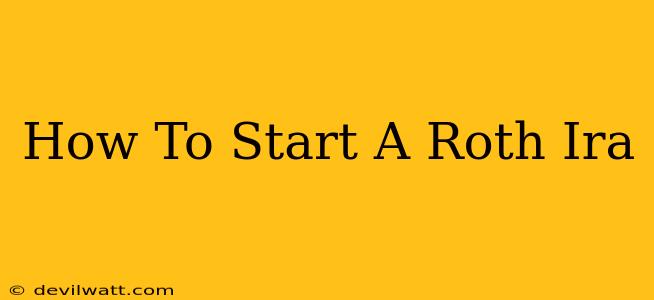Opening a Roth IRA can feel daunting, but it doesn't have to be. This comprehensive guide breaks down the process into manageable steps, helping you secure your financial future. A Roth IRA offers significant tax advantages, allowing your investments to grow tax-free and providing tax-free withdrawals in retirement. Let's get started!
Understanding the Basics of a Roth IRA
Before diving into the process, it's crucial to understand what a Roth IRA is and its benefits.
What is a Roth IRA? A Roth IRA is a retirement savings account where contributions are made after tax, meaning you've already paid taxes on the money you contribute. However, qualified withdrawals in retirement are tax-free! This contrasts with a traditional IRA, where contributions are tax-deductible but withdrawals are taxed in retirement.
Key Advantages of a Roth IRA:
- Tax-free withdrawals in retirement: This is the biggest draw. You won't owe taxes on your withdrawals once you reach retirement age.
- Tax-free growth: Your investments grow tax-deferred, meaning you won't pay taxes on the investment gains until you withdraw them (and with Roth IRAs, you won't!).
- Flexibility: You can withdraw your contributions at any time, tax- and penalty-free. However, be aware of rules surrounding early withdrawals of earnings.
Who Should Consider a Roth IRA? A Roth IRA is generally a good choice for those who:
- Expect to be in a higher tax bracket in retirement: Paying taxes now at a lower rate and enjoying tax-free withdrawals later is advantageous.
- Are young and starting their retirement savings early: The power of compounding works best over a long period.
- Believe their income will increase over time: Again, paying taxes now while in a potentially lower tax bracket can be more beneficial in the long run.
Step-by-Step Guide to Opening a Roth IRA
Now let's walk through the process of opening your Roth IRA.
Step 1: Choose a Brokerage Account
Several reputable brokerage firms offer Roth IRAs. Consider factors like fees, investment options, research tools, and customer service when making your selection. Some popular choices include Fidelity, Vanguard, Schwab, and others. Research different platforms to find one that best suits your needs and investment style.
Step 2: Determine Your Contribution Limit
The IRS sets an annual contribution limit for Roth IRAs. This limit can change yearly, so it's essential to check the current amount. For 2023, the contribution limit is $6,500, with an additional $1,000 catch-up contribution allowed for those age 50 and older.
Step 3: Fund Your Account
Once you've chosen a brokerage and understand the contribution limits, you can fund your account. You can transfer funds from your checking or savings account electronically or via other methods offered by your chosen brokerage.
Step 4: Choose Your Investments
Roth IRAs offer a wide range of investment options. These can include stocks, bonds, mutual funds, ETFs, and more. It's essential to choose investments aligned with your risk tolerance, investment goals, and time horizon. If you're unsure where to start, consider diversifying your portfolio across different asset classes. Consider seeking advice from a financial advisor if needed.
Step 5: Monitor and Rebalance Your Portfolio
After opening your Roth IRA and making your initial investments, regularly monitor your portfolio's performance. This allows you to adjust your investment strategy as needed, rebalancing your portfolio to maintain your desired asset allocation.
Frequently Asked Questions (FAQs)
- What is the income limit for contributing to a Roth IRA? There are income limits for contributing to a Roth IRA. If your modified adjusted gross income (MAGI) exceeds a certain threshold, you may not be eligible to contribute the full amount or at all. Check the IRS website for the most up-to-date information.
- Can I withdraw contributions from my Roth IRA before retirement? Yes, you can withdraw your contributions at any time without penalty. However, withdrawing your earnings before age 59 1/2 generally incurs penalties unless certain exceptions apply.
- What happens if I change jobs? You can typically keep your existing Roth IRA when you change jobs. You don't need to close it or roll it over.
Conclusion
Starting a Roth IRA is a significant step towards building a secure financial future. By following these steps and understanding the basics, you can effectively utilize this powerful retirement savings tool. Remember to consult with a financial advisor for personalized advice tailored to your specific circumstances.

